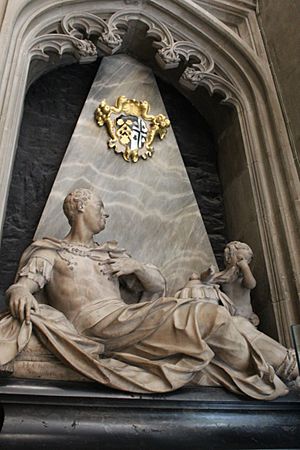Thomas Hardy (Royal Navy officer, died 1732) facts for kids
Quick facts for kids
Sir
Thomas Hardy
|
|
|---|---|
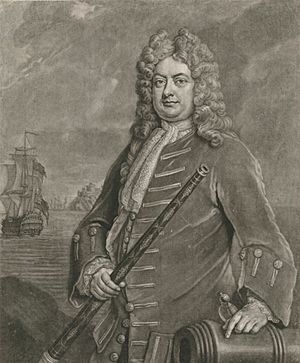
Mezzotint of Hardy by John Faber the Younger, based on an earlier portrait by Michael Dahl
|
|
| Born | 13 September 1666 Jersey |
| Died | 16 August 1732 |
| Buried | |
| Allegiance | Kingdom of Great Britain |
| Service/ |
Royal Navy |
| Years of service | 1688–1716 |
| Rank | Rear-Admiral |
| Commands held | HMS Charles HMS Swallow Prize HMS Pendennis HMS Deal Castle HMS Coventry HMS Pembroke HMS Bedford HMS Kent HMS Albemarle HMS Royal Sovereign HMS Russell The Nore |
| Battles/wars | |
| Awards | Knight bachelor |
| Spouse(s) | Constance Hook |
| Relations | Sir Charles Hardy (cousin) |
| Other work | High Sheriff of Dorset MP for Weymouth and Melcombe Regis Master of Trinity House |
Rear-Admiral Sir Thomas Hardy (1666–1732) was an important officer in the Royal Navy. He joined the navy before 1688. His career was helped by Captain George Churchill. Hardy served as Churchill's first officer during the Battle of Barfleur in 1692.
He became a captain in 1693. Hardy served near the Channel Islands and England. In 1702, he commanded HMS Pembroke off Spain. He fought at the Battle of Cádiz. Later, his chaplain helped him find the French and Spanish fleet. This led to the Battle of Vigo Bay. Hardy was made a knight for his brave actions.
In 1706, Hardy commanded a small group of ships. His job was to protect merchant ships in the English Channel. In 1707, he escorted a large convoy of 200 ships to Lisbon. He met a French squadron led by René Duguay-Trouin. Hardy chased them but returned to protect the convoy. He was later investigated for not fully fighting Duguay-Trouin. However, he was found innocent.
In 1708, Hardy became the first captain to Sir John Leake in the Mediterranean. He helped transport Elisabeth Christine of Brunswick-Wolfenbüttel to Spain for her marriage. He also helped capture Cagliari and Minorca. In 1711, he became a rear-admiral. He was given command of ships to blockade Dunkirk. A storm pushed him away, allowing French privateers to escape and attack a British convoy.
Hardy briefly commanded the Nore, Thames, and Medway areas. In 1712, he commanded ships off Ushant. He failed to stop French squadrons but was not blamed. In 1715, he was second-in-command of the Baltic Fleet during the Great Northern War. He was dismissed from the navy in 1716. This was likely because he supported the old royal family after the new one took over.
Contents
Thomas Hardy was born on Jersey on 13 September 1666. His father, John le Hardy, was a lawyer in Jersey. Thomas came from a family with naval connections. His cousin, Sir Charles Hardy, also became a high-ranking naval officer.
Thomas Hardy joined the Royal Navy before 1688. He started as a clerk for Captain George Churchill. Churchill later helped Hardy advance in his career. By 1692, Hardy was a lieutenant. He served as the first lieutenant on Churchill's ship, HMS St Andrew. During the Nine Years' War, he fought in the Battles of Barfleur and La Hougue in May 1692.
First Commands
On 6 January 1693, Hardy was promoted to captain. He took command of HMS Charles, a 6-gun fireship. In May, he moved to the 18-gun frigate HMS Swallow Prize. On Swallow Prize, Hardy protected Guernsey merchant ships from French privateers in the Channel Islands.
From 1695 to 1696, he also served as High Sheriff of Dorset. In September 1695, he took command of the new 48-gun ship, HMS Pendennis. He sailed with Captain John Benbow's squadron in October. They protected a convoy of ships carrying masts from Norway. Hardy commanded Pendennis until the Nine Years' War ended in September 1697.
His next command was in May 1698, the 20-gun frigate HMS Deal Castle. Hardy changed commands often during this time. He moved to HMS Coventry (50 guns) in April 1701. Then, in January 1702, he took command of HMS Pembroke (60 guns).
Battles and Knighthood
During the War of the Spanish Succession, Pembroke joined Admiral Sir George Rooke's fleet. They were off the coast of Spain. Pembroke fought in the Battle of Cádiz. This battle was an attempt to capture Cádiz from the Spanish. Rooke's fleet arrived on 12 August, and landings began three days later.
Pembroke and HMS Lenox bombarded the fort protecting the landing site. The Anglo-Dutch army successfully landed. On 25 August, Pembroke led a probe into the Bay of Cádiz. The ship even ran aground briefly. However, Cádiz's defenses were too strong. The army left between 15 and 16 September.
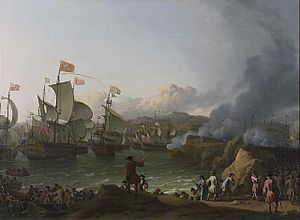
After Cádiz, Pembroke joined a squadron led by Captain James Wishart. They sailed to Lagos for water supplies. There, Hardy's chaplain, also from Jersey, went ashore. Locals thought he was French. The French consul boasted that the Spanish treasure fleet had arrived from the West Indies. He said it was hiding off Vigo.
Hardy quickly told Rooke about the fleet's location on 6 October. Rooke sailed his fleet to Vigo. On 12 October, they fought the successful Battle of Vigo Bay. They captured or destroyed the entire enemy fleet. After the battle, Rooke sent Hardy to England with news of the victory. Queen Anne rewarded him with a knighthood on 31 October. In January 1703, Hardy was given a new command, HMS Bedford (70 guns).
Mediterranean and Channel Service
Mediterranean Operations
Bedford was sent to the Mediterranean Fleet under Admiral Sir Cloudesley Shovell. On the way, Hardy commanded a small group of four ships. His task was to gather information at Lagos. The Portuguese could not provide much information about French movements. However, they did tell him the size of the French fleet in Toulon.
Hardy's time in the Mediterranean was mostly quiet. He did capture a valuable ship sailing from Santo Domingo. In October, Hardy took three ships to Tangier, Morocco. He delivered diplomatic papers. The rest of Shovell's fleet returned to England. After his task, Hardy also sailed home, arriving at Plymouth on 12 November.
Hardy sailed with the Mediterranean Fleet again in January 1704. This time, Admiral Rooke was in command. Bedford was part of Rear-Admiral Thomas Dilkes's squadron. In March, they patrolled off the Tagus. Dilkes heard about a Spanish force nearby. On 12 March, the squadron attacked. They captured two enemy warships and an armed merchant ship. Hardy was not present for the surrender.
Hardy was also not at the capture of Gibraltar in early August. But on 13 August, Bedford fought in the Battle of Málaga. Hardy's ship was in the center of the fleet. Seventy-four of his crew were injured or killed.
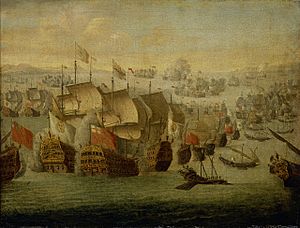
Vice-Admiral Sir John Leake took command in the Mediterranean in 1705. Hardy joined him in February, again in Dilkes's squadron. Towards the end of the year, Hardy returned to England. He left Bedford and was appointed to HMS Kent (70 guns) on 13 December. In summer 1706, Kent joined Vice-Admiral Sir Stafford Fairborne's squadron in the Bay of Biscay. It then helped in the successful siege of Ostend from June to July.
Protecting Convoys
In October 1706, Hardy became a commodore. He commanded a small squadron to protect merchant ships. These ships traveled through the Bay of Biscay and the western English Channel. Ten days after taking command, Hardy captured a well-known French privateer. This privateer had recently captured two British merchant ships.
Hardy continued commanding his squadron into 1707. He dealt with bad weather and sometimes escorted convoys from Ireland to England. The French squadron of René Duguay-Trouin was also in the Channel. But Duguay-Trouin moved to Portugal, making Hardy's area safer for incoming ships.
Escorting the Lisbon Convoy
On 13 June, Hardy was ordered to escort a convoy of about 200 merchant ships to Lisbon. His squadron was made larger for this task. His orders were changed to protect ships going to other places too. This was because of fears that Duguay-Trouin was still in the Channel. Hardy was to stay with the convoy until it was safely out of the Channel. Then, he would protect ships returning from Portugal. The convoy sailed from Spithead in early July.
The convoy moved slowly down the Channel due to winds. They finally cleared it on 24 August. Hardy had 150 merchant ships and 30 military supply ships left. Meanwhile, Duguay-Trouin had returned to the Channel. On 27 August, Hardy and the convoy were sailing off the Lizard. They met Duguay-Trouin's six-ship squadron.
Hardy first sailed to attack the French, as his orders required. But after several hours of chasing, he decided to return to protect the convoy. He feared the French would avoid him at night and attack the convoy. This decision was made with his captains. The convoy sailed safely, and Hardy left them on 30 August to continue their journey.
Hardy then patrolled off the Scilly Isles to protect returning merchant ships. They sometimes saw French privateers. But these ships stayed far away from Hardy's squadron. On 10 September, Hardy's ships saw the French squadron of Rear-Admiral Claude de Forbin. Hardy thought it was Duguay-Trouin again. Hardy formed a battle line and chased Forbin. But the French were too far ahead and escaped by morning.
Court Martial and Parliament
In mid-September, Hardy's squadron returned to Torbay. The Lord High Admiral, Prince George of Denmark, accused Hardy of "neglect of duty." This was for not continuing to chase Duguay-Trouin. Hardy was tried by a court martial at Portsmouth on 10 October.
Hardy argued that protecting the convoy was more important than an uncertain chase. The court, led by Leake, found him completely innocent. They said Hardy had followed his orders and acted wisely.
Even though he was acquitted, Hardy's actions upset powerful merchants and politicians. In November, the Admiralty reviewed his case. A panel of admirals agreed that the court martial's decision should stand. Despite this, Hardy was brought before committees of the House of Lords and House of Commons. They wanted to investigate failures to protect merchant ships.
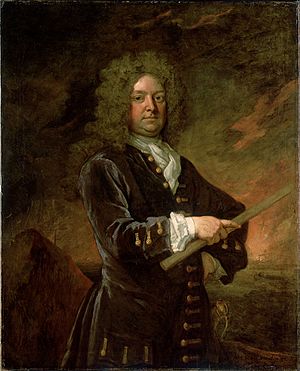
The House of Commons committee examined Hardy's court martial papers on 22 November. But the evidence did not challenge the earlier decision. The debate was quickly dropped. Hardy left Kent in January 1708. His examination before the House of Lords in February was more detailed. He faced an extra charge of refusing to escort a merchant ship. But Hardy was again found innocent. These parliamentary investigations were seen as unfair.
Later Career and Retirement
Return to Service
Sir John Leake, influenced by Churchill, showed his support for Hardy. He appointed Hardy as the first captain of his flagship, HMS Albemarle. This was a 90-gun ship for the Mediterranean. Hardy joined the fleet after it reached Lisbon.
From Lisbon, the fleet went to Barcelona, Spain. Hardy was sent to the court of Elisabeth Christine of Brunswick-Wolfenbüttel at Vado. She was to marry Archduke Charles, a British ally. Hardy helped plan her move to Spain with Leake's fleet. He returned on 9 June. Leake then left Albemarle, leaving Hardy in command.
Hardy, with five other ships, embarked Elizabeth Christine on 2 July. The fleet took her to Barcelona, where she married Charles. The fleet then captured Cagliari, the capital of Sardinia, on 1 August. They then sailed to Minorca and blockaded it. An allied army arrived to attack the island. Leake sent part of his fleet to help. He then sailed for England with the rest, including Hardy, on 19 September. They arrived off Portland on 15 October.
Hardy continued with Leake in the English Channel. In December, Hardy was appointed to Leake's new flagship, HMS Royal Sovereign (100 guns). In May 1709, he moved with Leake to HMS Russell (80 guns). They both left Russell in July. In 1710, Hardy became an elder brother of Trinity House.
Flag Rank and Final Commands
On 27 January 1711, Hardy was promoted to rear-admiral of the blue. In April, he became a Member of Parliament for Weymouth and Melcombe Regis. His naval duties meant he spent little time in parliament.
Hardy also commanded a squadron to blockade Dunkirk, France. His flagship was Canterbury. He captured a French merchant ship trying to sail to Newfoundland around 26 April. The squadron arrived off Dunkirk on 21 May. They forced two privateers and a small boat into the port. Hardy was tasked with stopping a French privateer squadron from escaping. He also needed to intercept a convoy from Brittany. He captured several small privateers.
His squadron was later blown off station by a storm. They had to shelter in Yarmouth Roads. On 8 August, Hardy was ordered to escort a convoy to Russia as far as the Orkney Islands. He sailed with them to the Shetland Isles and then returned to England. From there, he was sent to find the French squadron of Jean-Baptiste du Casse, but du Casse escaped. Hardy then tried to restart his blockade of Dunkirk. However, the French escaped before he arrived. They captured sixteen out of twenty-two ships from a convoy from Virginia. Hardy was not blamed for this.
Hardy was considered to lead the Quebec Expedition. This was an attempt to capture Quebec with warships and troopships. But he was not chosen. His squadron arrived at Plymouth on 23 October. On 6 October, Hardy had been made commander-in-chief, the Nore, Thames and Medway. He held this command until early 1712.
In January 1712, Hardy was given a new squadron. He served off Ushant, with Kent as his flagship. He was tasked with stopping the squadrons of du Casse and Duguay-Trouin off Cape Finisterre. He failed to stop either, but was not found at fault. In August, Hardy's squadron found and chased a French squadron of six merchant ships. The French ships tried to escape. Hardy captured four of them, and a fifth blew up. The sixth ship escaped. At this time, there was a ceasefire for peace talks. The captured ships were later released to avoid legal problems.
Dismissal and Final Years
The Peace of Utrecht ended the War of the Spanish Succession. Hardy gave up his command. He lost his Weymouth seat in the 1713 election. But he got it back on 3 June 1714. On 11 June, he helped manage the Longitude Act bill. This bill offered a reward for finding a way to measure longitude accurately. The bill became law on 9 July.
In 1715, Hardy was second-in-command to Admiral Sir John Norris. They were in the Baltic Fleet for the Great Northern War. Hardy's flagship was HMS Norfolk (80 guns). They sailed on 18 May and arrived on 10 June. They joined an allied Dutch fleet. The fleet mostly escorted merchant ships safely into port. Hardy left this position later that year.
This was his last active service in the Royal Navy. He was dismissed from the service in 1716. This was likely because his political views were not favored by the new king, George I. Many members of Hardy's political party were thought to support the old royal family. The new government removed many of them from power. Hardy also lost his seat in the 1715 election.
Hardy remained involved in naval circles after his dismissal. He served two terms as Master of Trinity House between 1729 and 1730. He died on 16 August 1732, at age 67. He was buried with his late wife in Westminster Abbey. His monument, designed in 1737, shows him in Roman armor.
Personal Life
Hardy married Constance Hook (who died on 28 April 1720) before 1710. She was the daughter of Colonel Henry Hook. He was the Lieutenant-Governor of Plymouth. Thomas and Constance had three children: one son and two daughters. Their son, Thomas, and younger daughter, Charlotte, never married. Their other daughter, Constance, married the politician George Chamberlayne. She inherited Hardy's estate in Middlesex when he died.


